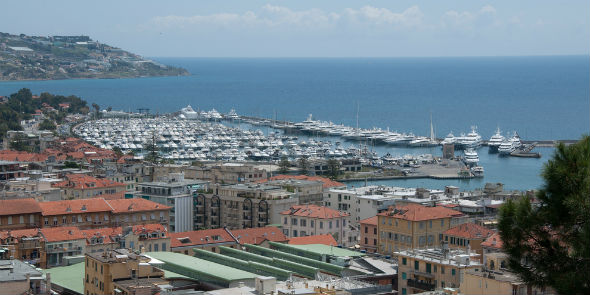The singsong of a hundred conversations carries over the Piazza Eoi Sanremesi, looked upon by wide bluebell skies. It is Tuesday and Mercanto Annonario, San Remo’s prolific food market, is in full swing.

San Remo. (Photo: J. Mangelsdorff via Flickr)
The scent of virgin Ligurian olive oil lingers in the air and the Mediterranean sun beats down upon a kaleidoscope of ruby-red beef tomatoes, prized porcini mushrooms, sheaths of handmade pasta, rough-cut Italian cheese and cured meats. Leather-skinned vendors argue animatedly with shopkeeps leaning in shaded doorways, while scooters zip past, a dime a dozen. Glaze-eyed sea bass, sole and sardines lie packed in polystyrene shelves of ice beside clusters of prickly sea urchins and piles of shrimp. A handful of sunburnt tourists drift amongst the swathes of locals bartering for the very best ingredients.
Sandwiched between the indigo seas and sweeping hillsides of the Riviera dei Fiori, San Remo sits at the top of Italy’s boot, just a stone’s throw from its glitzy French cousin, the Cote d’Azur. The ‘City of Flowers’, so-named for its export of roses, carnations and buttercups, was once a glamorous playground for wealthy hedonists. Back in the 19th century, Russian Empress Maria Aleksandrovna was so taken with the vast seafront that she had a row of palm trees planted there; the tree-lined Corso della Imperatrice has since adopted her name. A wander along the promenade is best when punctuated with a pitstop at one of the many traditional seaside cafes here that serve up rich and crispy tomato sardenaira, herb-strewn olive focaccia and bitter expresso.
The affluent Russian community that took to holidaying here left a timeless print that transcends the crumbling walls of their favourite haunts. It is tangible both in feeling – Tchaikovsky completed Eugene Onegin and wrote his Fourth Symphony here in 1878 – and in flesh, most notably the Russian Orthodox Church. With classic onion domes and elaborate turrets, the imposing structure slots in amongst a diverse array of architecture, from the Corso degli Inglesi’s liberty-style villas to the baroque Boreo d’Olmo Palace overlooking the Corso Matteoti. This particular Corso is the leading strip in San Remo, a wide avenue of colourful facades dotted with quintessential boutiques selling soft leather goods and high quality cashmere.
Those in search of San Remo’s soul follow the Corso’s shiny windows and rainbow facades north towards the gothic Porta di Santo Stefano. Beyond this archway, La Pigna, the oldest part of the city, curls cobbled streets around the hillside, reminiscent of the pinecone to which it owes its name. This walled quarter was built in medieval times to protect San Remo from pirates scouring the bays of the Riviera. La Pigna is an ideal spot to wile away a sunny afternoon, with its tangle of charming alleys and piazzas laced with churches, each decorated with marble statues and elaborate frescoes tinged with gold. Perhaps the most atmospheric of all is the Madonna della Costa Sanctuary, which lies at the top of the hill past an intricate cobblestone mosaic and displays art from the 17th and 19th centuries.
Just a short drive from town sits Bussana Vecchia, a tiny medieval village that was abandoned in the late 1800’s after it was devastated by an earthquake. In the 1960’s, the village was salvaged by a community of bohemian artists who breathed new life into ruin by renovating some of the decayed buildings. It is a surreal spot, half in disarray, but the ancient village is fascinating for its hippy community and their accomplished artwork. Surrounded by crooked pine trees, olive groves, fields of heather and myrtle, the ancient village remains a worthy day trip for art enthusiasts. In spring, the hillsides are veiled with delicate narcissus panizzianus, a tiny snowflake-white flower typical of the region.
Permanent attractions aside, San Remo also plays host to a number of important cultural events, from the flower parades and laidback festival of street art in winter to a number of annual jazz, rock and classical music events dispersed throughout the lengthy summer evenings. The town opens its doors to classic car rallies in spring and a variety of sailing competitions in autumn, bringing in an eclectic, far-flung crowd and truly making the most of the coastline.
But perhaps the most longstanding attraction of all is the Old World Casino, a notorious spot for those partial to sinking their savings in a risky fashion. It is arguably the most famous Casino on the Italian Riviera and if its great Art-Nouveau facets could speak, the Casino would have a thousand stories to tell of legends and scandals, debauchery and times gone by. Just practice your poker face, for it was once said, ‘if you lose in San Remo, you lose it elegantly, in a respectable way.’ Indeed, for what San Remo may have lost in glitz and glamour, it more than makes up for in charm and quiet sophistication.